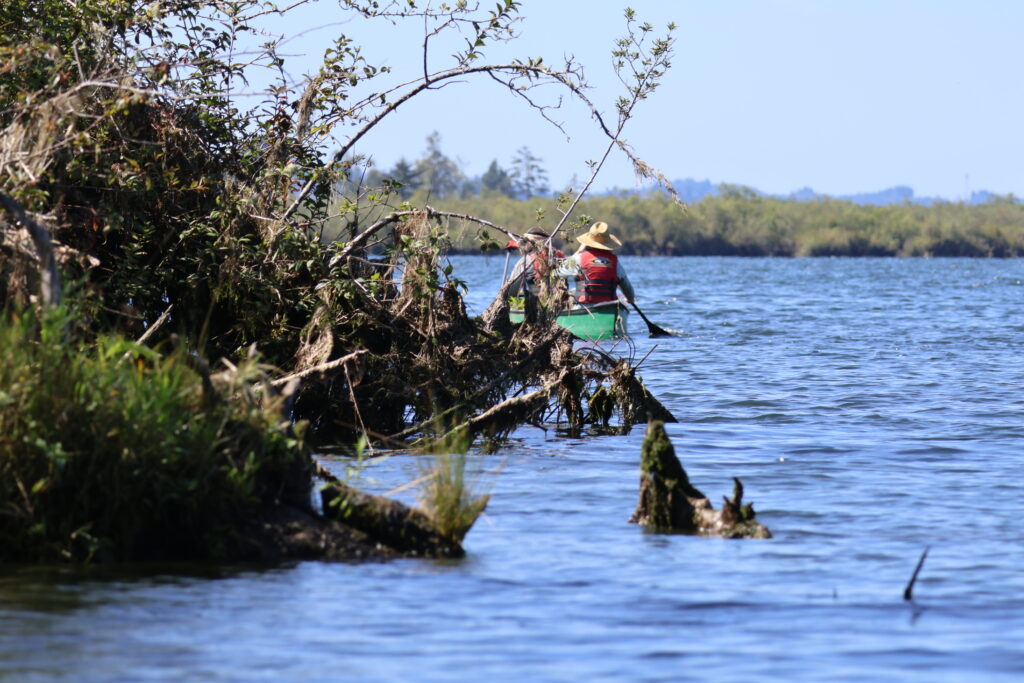At NCLC, it’s not uncommon for our stewardship schedule to ebb and flow with the natural changes taking place on the ground. We get to respond to what’s happening seasonally and cyclically in the habitats we preserve and care for.
In late summer, for example, our stewardship team likes to turn attention and effort toward removing purple loosestrife (Lythrum salicaria), a non-native invasive perennial that has spread widely in Oregon. It is an aquatic invader, meaning it likes to grow on the shorelines of wetlands, lakes, and rivers—which we have plenty of in our service area! The plant can grow up to 7 feet tall, supported by a large rhizomatous root mass, according to the Oregon Department of Agriculture.

Stopping the Spread of Seeds
Purple loosestrife grows bright magenta flowers, which is why we wait until later in the summer to work on removing it at our reserves. It’s much easier to spot the vibrant blooms, especially if you’re in a canoe or kayak at Blind Slough or the John Day River.
“If you pulled it earlier in the year, it would still be equally as effective,” Stewardship Manager Eric Owen says. “But looking at it on the banks, it would be hard to see if it didn’t have the purple flowers on it right now.”
On the flip side, you want to pull it up—ideally, roots and all—before it goes to seed and causes further damage along the Columbia River system, especially since one mature plant can produce approximately 2.5 million seeds.
“That’s a lot of seeds that they could send downstream,” Eric says. Hence why this time of year tends to be the sweet spot.
Over the past month or so, purple loosestrife has been the focus of our Weed Warrior Wednesdays, and help from a very steadfast and dedicated crew of volunteers has enabled us get rid of large piles of the weed at Wolf Bay, John Day River Marsh, and Blind Slough Swamp habitat reserves. Fortunately, we’ve only observed it on a few of our other reserves, such as Skipanon Forest, Wild Ace Lake, and Spirit Lake, and it hasn’t made a broader appearance on our conserved lands.
Working with Partners and Volunteers
Pulling purple loosestrife is also the objective behind our annual two-day work party at Blind Slough, known as Swampathon! We had a great turnout for the event this year, which took place Aug. 10 and 11. Several canoes filled with two-person teams spread out across Blind Slough, Warren Slough, and Prairie Slough to hunt for this noxious purple invader.
Earlier this week, on Aug. 28, we also partnered with a crew from Lewis and Clark National Historical Park to continue the job at Blind Slough, hauling in a truckload of loosestrife. On a separate note, this is the third time we’ve had the pleasure of teaming up with the natural resources crew from the park for a work-exchange initiative that’s become a tradition between our two organizations during the summers.
But back to Blind Slough, there’s a reason we spend a great deal of time traversing the waterways, hunting for purple loosestrife.
“It’s worth it because the habitat is so cool, and it’s a really special habitat,” Eric says. “It’s old-growth Sitka-spruce swamp, one of the rarer habitat types.”

A Rare and Special Habitat
Much of the forested floodplain along the Oregon side of the lower Columbia River was logged off and diked for pasture long ago. But pockets of the original Sitka-spruce swamp remain, thanks to dedicated conservation efforts. Blind Slough Swamp is the best remaining example in Oregon of this habitat type.
The preserve is dominated by Sitka spruce trees—some more than 400 years old—with younger western redcedar and western hemlock also present, along with some less common Oregon ash and black cottonwood. Dense thickets of coast willow, Sitka willow, twinberry, and Nootka rose line the channels along with abundant sedges, wildflowers, and bulrushes. A few different types of orchids grow in the reserve, along with native mint, corn lilies, and tule.
“Purple loosestrife can grow in really dense populations and out-compete the native plants,” Eric says. “It can start to displace them.”
You want to support the native habitat and help it thrive, especially in a place like Blind Slough Swamp, which provides critical habitat for an abundance of birds, fish, and other wildlife, including bald eagles, osprey, river otter, beaver, coho salmon, nesting yellow warblers, olive-sided flycatchers, and rufous hummingbirds.
How to Help With Prevention
Purple loosestrife seeds also spread through human activity, unintentional as it might be, and that’s where we all can pitch in. As with the majority of invasive plants, prevention is the best practice. A few ways to prevent the spread include:
- Cleaning boots, pets, and tires when hiking or trail riding in natural areas (so you don’t introduce plants from one place to another)
- Rinsing off kayaks, canoes, and boats, especially if you’re taking them from one water system to another
- Being careful and attentive when sharing or trading plants with friends, neighbors, and fellow gardeners
- Properly disposing of invasive plants
Even small steps can go a long way in caring for the incredible natural environments that comprise the Lower Columbia River region on the Oregon Coast!

Comments